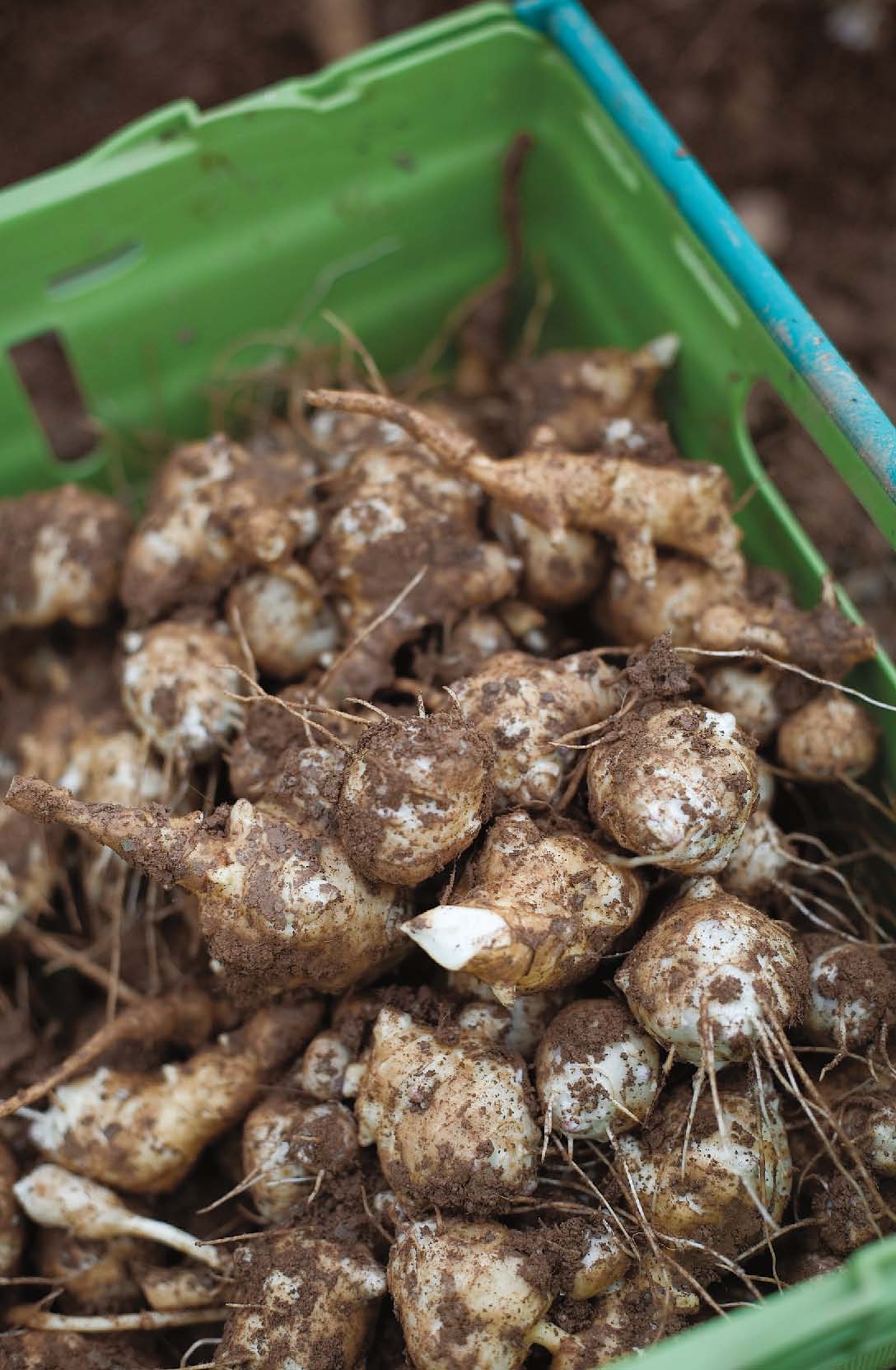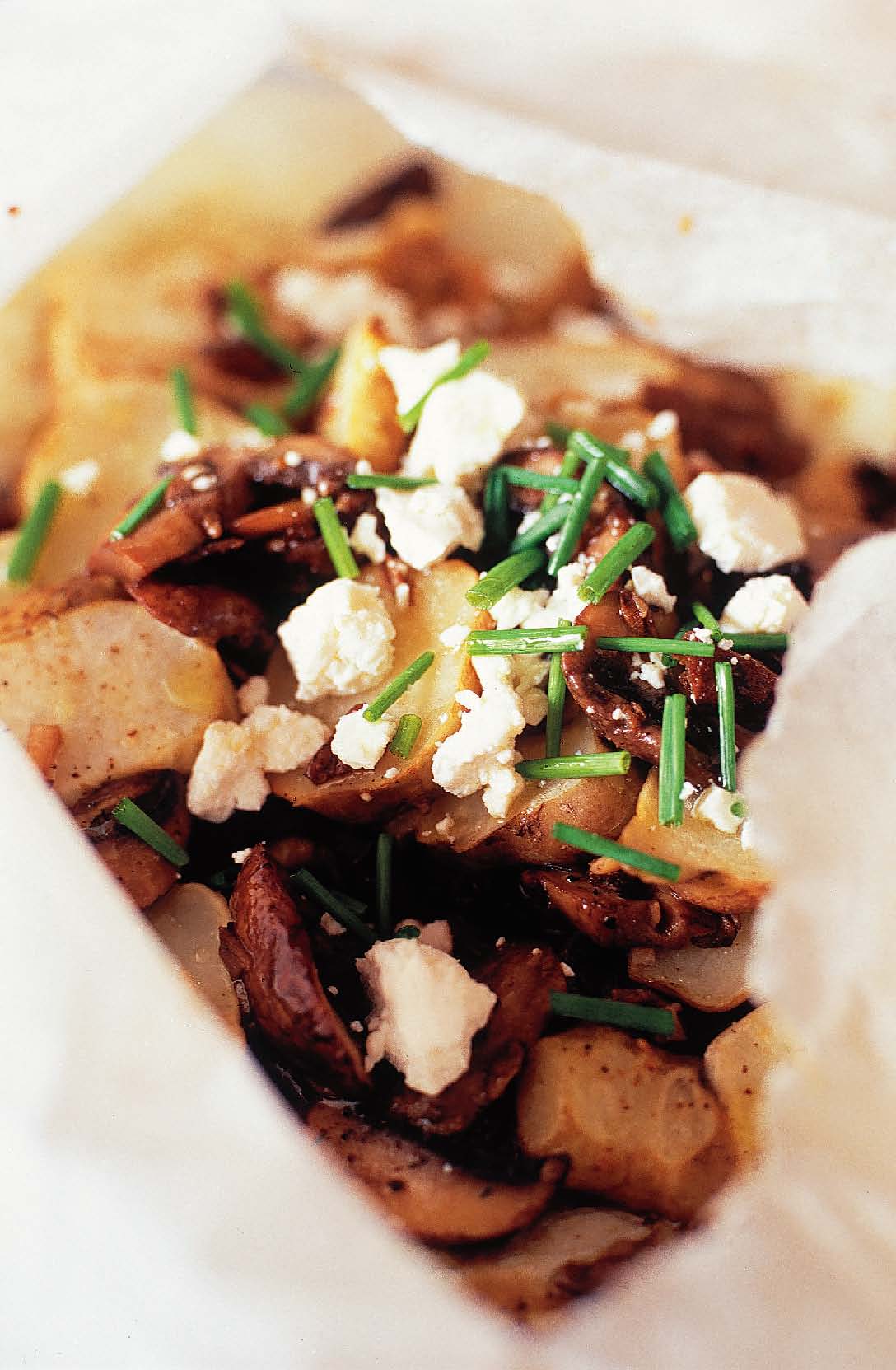Jerusalem Artichokes
Jerusalem artichokes are in no way related to globe artichokes. The name Jerusalem is said to be a corruption of girasole, Italian for the closely related sunflower. This seems more plausible when they briefly burst into their yellow blooms in late September. The plant originates from North America, where artichokes were cultivated and gathered from the wild by the Native Americans. They arrived in the UK via Holland in 1617. After a period of popularity in the 1980s, they seem to have fallen from favour and are now grown mainly as pheasant cover. We have recently reduced the acreage we grow, but personally I think they are a taste well worth acquiring.
Farmers love to grow Jerusalem artichokes. They suffer no serious diseases or pests and are vigorous enough to out-compete even the most aggressive weeds, growing to a height of 3 metres in five months. Indeed, a more serious issue is getting rid of them when it is time for the field to be returned to grass or another crop. If we could fill our vegetable boxes with Jerusalem artichokes all winter, our lives would be simple. Unfortunately their agronomic simplicity is not reflected in their popularity; this is a vegetable that threatens marriages.
Given the litigious age in which we live, I always issue a warning in the newsletter the first time artichokes go in the boxes in autumn, about their legendary flatulence-inducing properties. Think baked beans and multiply by ten and you might be getting close. My wife will not have them in the house, although my sons always rather enjoy their effects. Some consolation for those with more delicate sensibilities can be drawn from the fact that, unlike the cabbage family, the effect is more thunderous than malodorous. I am advised by a herbalist friend that the disturbance can be reduced by cooking the artichokes with bay leaves, or possibly by eating fennel.
The tubers are planted in March or April in ridges, just like potatoes. They emerge with tremendous vigour and spend all summer growing a huge frame, before bursting into bright-yellow flower and concurrently filling their tubers as they senesce, just before the first frosts in October. Flowering normally coincides with the harvest festival and we often use the blooms to help decorate our parish church. The roots are frost hardy and are best stored in the ground, so we lift them as and when we need them for the boxes through the winter.

Storage and preparation
In early winter, artichokes will keep for several weeks in a vegetable rack in a cool, damp place (the main loss of quality is through dehydration, which is why a damp place is good). As spring approaches, they show a tendency to sprout; this can be delayed by keeping them in the fridge, ideally in a perforated plastic bag. Unlike potatoes, they do not turn green in the light, though they sometimes develop a harmless reddish tinge.
Artichokes are a very minor crop, so no one has done much breeding, but a few years ago we discarded the stock I had multiplied up from my mother’s garden and replaced it with the larger, smoother, more regular and, crucially, easier to peel Fuseau variety. Even so, they are painstakingly slow to peel. If you grow them yourself (which I would not really recommend unless you have a large garden, because they tend to dwarf everything and are hell to get rid of), make sure you select large, round seed tubers. Not everyone feels you have to peel them – you can just give them a bit of a soak to loosen the mud and a good scrub.
The easiest way to use artichokes is in soups or roasted, though Jane has developed several more sophisticated uses in the Field Kitchen. They can be good in a gratin, as long as you don’t add too much liquid or they can end up watery. The same applies to soup. They benefit from Jane’s beloved truffle oil, especially in salad, and also go well with hazelnuts – Jane sometimes toasts these and uses them in the Jerusalem Artichoke Soup on the facing page.
Jerusalem Artichoke Soup
A classic soup with lots of possible variations for a couple of ideas).
Serves 4
1 tablespoon olive oil
1 onion, chopped
500g Jerusalem artichokes, scrubbed and thinly sliced
800ml chicken or vegetable stock
100ml single cream
sea salt and freshly ground black pepper
Heat the oil in a large pan, add the onion and fry gently for 5 minutes. Add the artichokes and stock, bring to the boil and simmer for 20 minutes, until the artichokes are tender. Blend the mixture until smooth, then season to taste and reheat gently. Stir in the cream and serve.
♦ Try this soup with hazelnuts. Add 50g ground toasted hazelnuts when blending the soup.
♦ Or adding polenta croûtons, Parmesan and white truffle oil makes a tasty alternative. Deep-fry cubes of cooked polenta to make croûtons. Replace the cream with 2 tablespoons of freshly grated Parmesan cheese. Serve the soup with the croûtons, an extra sprinkling of Parmesan and a drizzle of white truffle oil.

Jerusalem Artichokes and Mushrooms in a Bag with Goat’s Cheese
When in doubt, put it in a bag. These earthy flavours work so well together and look quite rustic when served in their parchment bags. As always with Jerusalem artichokes – and mushrooms – a drizzle of truffle oil would make a fabulous addition.
Serves 4
4 large Jerusalem artichokes, scrubbed and cut into rounds 1cm thick
juice of 1 lemon
4 tablespoons olive oil
1 teaspoon thyme leaves
200g mushrooms, sliced
10g dried porcini mushrooms, soaked in 400ml boiling water for 30 minutes
2 garlic cloves, chopped
75g goat’s cheese, crumbled
1 tablespoon chopped chives
sea salt and freshly ground black pepper
Mix the artichokes with half the lemon juice, a tablespoon of olive oil and the thyme leaves, then set aside.
Sauté the fresh mushrooms quickly in 2 tablespoons of the remaining olive oil until they are just tender. Season well and remove from the pan.
Drain the porcini, reserving the soaking water. Chop roughly and cook in the remaining tablespoon of olive oil with the garlic for 2 minutes. Add the reserved soaking liquor and simmer until reduced and quite syrupy. Add the fresh mushrooms and the remaining lemon juice and season to taste.
Spread out a large square of baking parchment. Tip the artichokes over one half of it, sprinkle the mushrooms on top and then fold over the parchment. Seal the 3 open sides by folding them over tightly, or simply use a stapler.
Place the parcel on a baking tray and bake in an oven preheated to 200°C/Gas Mark 6 for about 45 minutes, until the artichokes are tender. Open the bag and sprinkle the contents with the crumbled goat’s cheese and the chives.
Jerusalem Artichokes with Leeks, Bacon and Sizzled Sage
This recipe came about at the end of the Jerusalem artichoke season, when we decided to try them with leeks. The bacon and sage came later and the whole combination was a success.
Serves 4
500g Jerusalem artichokes, peeled and thickly sliced
2 leeks, sliced at an angle into 2.5cm lengths
3 streaky bacon rashers, chopped
1 tablespoon lemon juice
4 tablespoons olive oil
a handful of sage leaves, coarsely chopped
sea salt and freshly ground black pepper
Put the artichokes in a pan of boiling salted water and simmer briskly for 15 minutes. Meanwhile, steam the leeks for 3 minutes, until they are just tender and still bright green. Fry the bacon over a moderate to high heat until brown and crisp.
Drain the artichokes, put them in a warmed serving bowl and sprinkle with the lemon juice. Scatter the leeks and bacon over the top and season with salt and plenty of pepper.
Heat the olive oil in a small frying pan until very hot. Add the sage and sizzle for 30 seconds – it will crisp up as it cools. Pour the oil and sage over the vegetables and serve straight away.
Easy ideas for Jerusalem artichokes
♦ Jerusalem artichokes are delicious eaten raw (and you won’t explode!). Slice them thinly and toss with a little lemon juice and olive oil. Lovely in a winter salad with chicory or radicchio, Parmesan slivers and white truffle oil.
♦ They are also great roasted: toss the artichokes with a few tablespoons of olive oil, spread them out on a baking tray with a few branches of thyme, some garlic cloves, and some salt and pepper and roast at 200°C/Gas Mark 6 for about half an hour, until tender.
♦ Dip 5mm-thick slices of Jerusalem artichoke in a light batter (try the one for courgettes on Easy ideas for courgettes and marrows), deep-fry them in oil and serve with Salsa Rossa (see Braised Shoulder of Lamb Stuffed with Salsa Rossa).
♦ Substitute Jerusalem artichokes for half the potatoes in the Basic Potato Gratin.